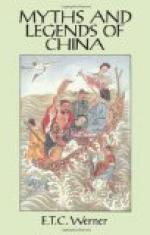Southern Origin Improbable
But this latter route would present many difficulties; it would seem to have been put forward merely as ancillary to the theory that the Chinese originated in the Indo-Chinese peninsula. This theory is based upon the assumptions that the ancient Chinese ideograms include representations of tropical animals and plants; that the oldest and purest forms of the language are found in the south; and that the Chinese and the Indo-Chinese groups of languages are both tonal. But all of these facts or alleged facts are as easily or better accounted for by the supposition that the Chinese arrived from the north or north-west in successive waves of migration, the later arrivals pushing the earlier farther and farther toward the south, so that the oldest and purest forms of Chinese would be found just where they are, the tonal languages of the Indo-Chinese peninsula being in that case regarded as the languages of the vanguard of the migration. Also, the ideograms referred to represent animals and plants of the temperate zone rather than of the tropics, but even if it could be shown, which it cannot, that these animals and plants now belong exclusively to the tropics, that would be no proof of the tropical origin of the Chinese, for in the earliest times the climate of North China was much milder than it is now, and animals such as tigers and elephants existed in the dense jungles which are later found only in more southern latitudes.
Expansion of Races from North to South
The theory of a southern origin (to which a further serious objection will be stated presently) implies a gradual infiltration of Chinese immigrants through South or Mid-China (as above indicated) toward the north, but there is little doubt that the movement of the races has been from north to south and not vice versa. In what are now the provinces of Western Kansu and Ssuch’uan there lived a people related to the Chinese (as proved by the study of Indo-Chinese comparative philology) who moved into the present territory of Tibet and are known as Tibetans; in what is now the province of Yuennan were the Shan or Ai-lao (modern Laos), who, forced by Mongol invasions, emigrated to the peninsula in the south and became the Siamese; and in Indo-China, not related to the Chinese, were the Annamese, Khmer, Mon, Khasi, Colarains (whose remnants are dispersed over the hill tracts of Central India), and other tribes, extending in prehistoric times into Southern China, but subsequently driven back by the expansion of the Chinese in that direction.




